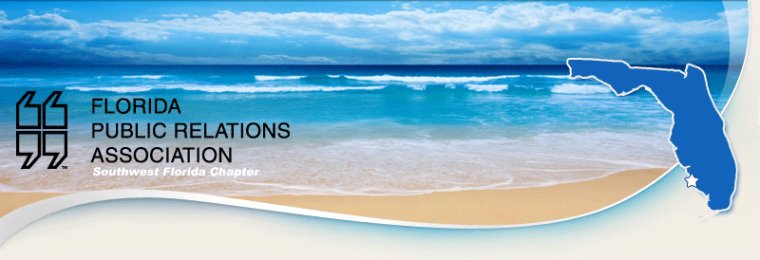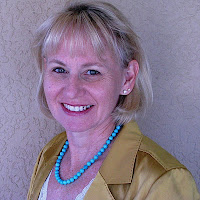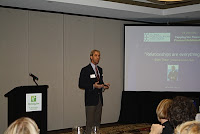Josh Hallett is currently director, Voce Connect at Voce Communications providing social media consulting and development work with brands such as Disney Parks, Playstation, Ebay, Best Buy, CBS, Yahoo, Intel, Logitech, NFL and Comcast, among others.
His presentation entitled “Social Media in the Trenches” focused on the strategy of social media campaigns and the measurement techniques that get the noticed as an effective advertising method.
No matter what size company you are, there is an audience you want to reach and that audience is online. All social media (even at companies like Play Station) started with one person, working part-time to develop initiatives. By having goals and initiatives in place, they were able to grow social media into what it is today.
There is a lot of work that goes on behind the scenes. Media sharing, social networking, listening infrastructure, internal management, content planning and development, and community management are all things that make up the background of social media. Start with the basic things, such as listening and responding, and then build out. Customers want to get responses to questions they ask of your brand.
Earn to Play. Paid to Play. You are making the play.
There are three forms of media. Earned Media, Paid Media and Owned Media. Earned media consists of PR, investor relations, and customer programs. Paid Media includes campaigns, sponsorships, print ads and online ads. Owned Media, is original content that is shared with publishing tools. Hallett explained the three types as earn to play, paid to play and you are making the play.
Think of social media as a distributed system, where your corporate blog is the hub and where you spread your content from the blog are the spokes. Its often times hard to go back and find a link you once saw on Facebook days later, but if you replicate the link on your Twitter page and on your blog, others will be able to reference it easier at a later time. It is also important to distribute your content so that the content will gain higher search rankings.
Use the four P’s to successful at this. The four P’s include:
Preparation
Publishing
Participation
Performance
Use Radian 6 to find out what people are saying about your brand. Find out what is actual, what is trending, what is not trending and why they are talking, or not talking about this. At Voce a team of 6 individuals are doing this data research and analysis every morning and then they continue to monitor the results throughout the day.
Issue Flagging
Flag all issues that warrant a response. Determine whether you need to respond or whether you just need to look. If you will respond, track the timeliness in which you do so. Issue flagging and responding works much like a help desk system would.
Ed-Cal is Hallett’s Bible as it determines all the content that is going on everyday and is color-coded and time-scheduled to show the next week to three weeks of planned social media. Hallett also refers to a Twitter/Facebook Ed-Cal, which tracks links, which fan pages content will be posted to and where content would be going.
It’s all about timing. If you send a Tweet at 9 AM, be sure to retweet it every few hours.
The daily ebb and flow of communications is kept out of emails at Voce Communications, because email goes silent so quickly. This also enables work to continue at a steady pace, even if a co-worker is out of the office.
Use WordPress for all publishing. Voce recently redid the CBS sites all on a WordPress platform. Use Bit.ly as a tracking tool. For photo sharing, use Flickr. For videos, use YouTube, but you can also use Viddler, which provides more detailed analytics. Spredfast will allow you to schedule tweets and updates, but as Hallett stated, “automation is the devil” and should be used as sparingly as possible.
Even with the multitude of tracking programs out there, Hallett said that he still uses the good old-fashioned spreadsheet. He hosts the spreadsheet in Google Docs and makes sure to monitor and maintain tracking daily. This takes a lot of staff time, but measurement is important to tell where the company should be putting more money.
SEO
Seed the channel! If you are launching a new product, prepare three talking points prepared for the release. Three to four months before the release, start writing blog posts with those message points blended in there. Do a Google search on something you mentioned and look for the ranking. Once the content of your three messages points rank high on SEO, you have hit a home run. This is a way to tease out your new product announcement in a slow and steady, drip format.
Search for your product or service and take a screen shot. Launch your campaign and then do the search again to see where you are. People can cut PPC (Pay Per Click) by having a good social media platform. You can also save on email lists, since you can reach those people on Facebook. Social media will also help you to save on paying for focus groups or product insights.
Don’t forget HRO, or Human Reader Optimized content. Make sure it makes sense.
CNN makes sure to post something new all the time so that people will come back. Post your content as often as you want people to come back. Usually, 50-60% of the traffic to your website is coming from content released two weeks earlier.
Monitor what people are saying about your brand, because you need to respond to them. Mine for long-term effects on brand awareness and perceptions. How are you saving money? How are you making money?
Measuring social media is no different from anything else you measure.
A link is the most valuable commodity online. It is saying: please leave where you are right now and visit somewhere else. This is how Google bases their algorithm – on where people are going.
What’s coming?
Metricly is coming out and it will allow you to put all the analytics, Google accounts and social media accounts in one software that will build charts and graphs on your data.
Many companies are also starting to use Twitter as customer support to answer questions to reduce the costs of on site of off site customer support centers.
Getting Started
Set measurable goals on the tools
Align measurement tools
Start tracking sheets
Benchmarking
Reporting frequently
Going offline
Build an online community and get them together offline as quickly as you can. Get them in the same physical location. Meetups are a very powerful thing. It will get you huge increases in engagement.
Survey to find out where your customers are in the realm of social media. Is your audience there? If not, why are you spending your time there?
Comments and shares on Facebook have four times greater rank on Edgerank, which is organized based on commonality of friends. For a small business, test certain messages and find out what you are driving interest in. Once you have the audience, ask them what they want to receive from you.
Post status updates with a question. Get others to respond to it and friends will able to see the responses. Know when your audience is on Facebook. If you post at 9 AM, your audience may not be on until 10 PM. Use teasers such as: Make sure to check out our page tomorrow at noon. Do you see an increase around the hours that you are asking them to come back?
Guest blogger: Diana Sabino, Southwest Florida College


























